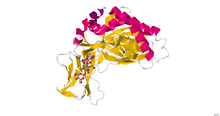HLA-DM
| major histocompatibility complex, class II, DM alpha | |
|---|---|
 Crystallographic structure of human HLA-DM.[1] | |
| Identifiers | |
| Symbol | HLA-DMA |
| Entrez | 3108 |
| HUGO | 4934 |
| OMIM | 142855 |
| RefSeq | NM_006120 |
| UniProt | P28067 |
| Other data | |
| Locus | Chr. 6 p21.3 |
| major histocompatibility complex, class II, DM beta | |
|---|---|
| Identifiers | |
| Symbol | HLA-DMB |
| Entrez | 3109 |
| HUGO | 4935 |
| OMIM | 142856 |
| RefSeq | NM_002118 |
| UniProt | P28068 |
| Other data | |
| Locus | Chr. 6 p21.3 |
HLA-DM (human leukocyte antigen DM) is an intracellular protein involved in peptide presentation by MHC class II.[2] It is encoded by the genes HLA-DMA and HLA-DMB.
In the endosomes, HLA-DM functions by promoting the dissociation of the CLIP peptide (a place holder peptide) from MHC class II which allows endosomal peptides to bind. Possibly by its preferential binding of the open, peptide-less conformation of MHC class II, HLA-DM then catalyzes peptide exchange, favoring more stable peptide-MHC complexes (which are resistant to DM action). Thus, HLA-DM is thought to play an important role in "editing" the peptide repertoire.
HLA-DM is a protein involved in the immune system. It is a molecular chaperone that works in lysosomes and endosomes. HLA-DM plays a role in the proper loading of peptides and presentation of the peptides in macrophages, dendritic cells, B cells, and other antigen presenting cells. The protein is unable to bind peptides itself, so it interacts with major histocompatibility protein II (MHCII)[3] to speed up the molecule’s binding and releasing of peptides. HLA-DM regulates the peptides that bind to MHCII and present the antigen on antigen presenting cells, therefore controlling which antigen(s) the body mounts an immune response to.
The genes for HLA-DM are located in the MHCII region of the human chromosome 6. The genes code for the alpha and beta chains that makeup the protein. HLA-DM consists of two polymers and three ligands: BETA-D-MANNOSE (BMA), CHLORIDE ION (CL), and 2-(ACETYLAMINO)-2-DEOXY-A-D-GLUCOPYRANOSE (NDG). The structure of HLA-DM was determined by x-ray diffraction at a resolution of 2.27 Å.
The Ramachandran Plot of HLA-DM can be seen here.
References
- ↑ PDB: 2BC4; Nicholson MJ, Moradi B, Seth NP, Xing X, Cuny GD, Stein RL, Wucherpfennig KW (April 2006). "Small molecules that enhance the catalytic efficiency of HLA-DM". J. Immunol. 176 (7): 4208–20. PMC 3412064
 . PMID 16547258. doi:10.4049/jimmunol.176.7.4208.
. PMID 16547258. doi:10.4049/jimmunol.176.7.4208. - ↑ Busch R, Rinderknecht CH, Roh S, Lee AW, Harding JJ, Burster T, Hornell TM, Mellins ED (October 2005). "Achieving stability through editing and chaperoning: regulation of MHC class II peptide binding and expression". Immunol. Rev. 207: 242–60. PMID 16181341. doi:10.1111/j.0105-2896.2005.00306.x.
- ↑ Pashine A, Busch R, Belmares MP, Munning JN, Doebele RC, Buckingham M, Nolan GP, Mellins ED (August 2003). "Interaction of HLA-DR with an acidic face of HLA-DM disrupts sequence-dependent interactions with peptides". Immunity. 19: 183–192. PMID 12932352. doi:10.1016/S1074-7613(03)00200-0.
3. Vogt Anne B, Kropshofer Harald (April 1999). "HLA-DM – an endosomal and lysosomal chaperone for the immune system". Trends in Biochemical Sciences. 24 (4): 150-154. doi:10.1016/S0968-0004(99)01364-X
External links
- Overview at Davidson College (student generated)
- Protein Data Bank